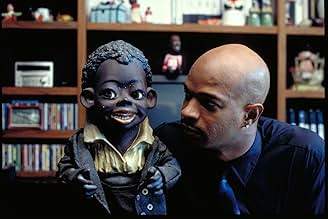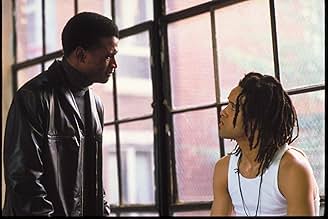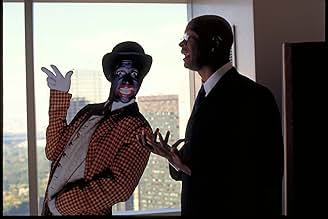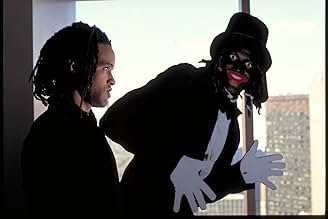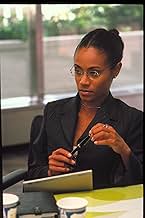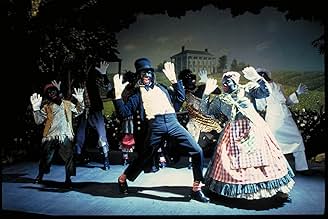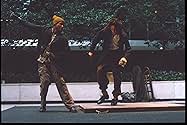VALUTAZIONE IMDb
6,7/10
12.821
LA TUA VALUTAZIONE
Aggiungi una trama nella tua linguaA frustrated African-American TV writer proposes a blackface minstrel show in protest, but to his chagrin, it becomes a hit.A frustrated African-American TV writer proposes a blackface minstrel show in protest, but to his chagrin, it becomes a hit.A frustrated African-American TV writer proposes a blackface minstrel show in protest, but to his chagrin, it becomes a hit.
- Regia
- Sceneggiatura
- Star
- Premi
- 2 vittorie e 10 candidature totali
Jada Pinkett Smith
- Sloan Hopkins
- (as Jada Pinkett-Smith)
Gillian White
- Verna
- (as Gillian Iliana Waters)
Yasiin Bey
- Big Blak Afrika
- (as Mos Def)
M.C. Serch
- Mau Mau: 1-16th Blak
- (as MC Serch)
Craig muMs Grant
- Mau Mau: Hard Blak
- (as Mums)
Dormeshia Sumbry
- Pickaninny: Topsy
- (as Dormeshia Sumbry-Edwards)
Recensioni in evidenza
I am absolutely embarrassed right now that I have never watched a Spike Lee film before. I have always wanted to see Do the Right Thing, which is generally considered his best film, and I even rented it once, but never got around to watching it. When Bamboozled opened last year, it sounded very interesting, but after the critics dismissed it as a failed attempt at satire, I decided to catch it later on, perhaps after I saw Do the Right Thing. Then I saw it was going to be played on television, so I found the time and sat down to watch. What I saw was something absolutely amazing.
And that's not to say that Bamboozled doesn't have its flaws. I would personally deem it a flawed masterpiece, a very flawed masterpiece. The critics were right: Lee's satire is misplaced. He's far too hotheaded an artist to have realized this immediately, but he should have when the New York Times refused to run the movie's add, which depicted a sambo character eating a watermelon, because they feared protests. Bamboozled asks us to suspend our disbelief - a disbelief which Spike Lee may not have had himself - and accept that a TV network would produce the New Millennium Minstrel Show and that the public, a la Mel Brooks' The Producers, would eat it up. Lee's argument in the press is that this was already happening. His targets were rap videos and a show on the WB network that only produced something like 6 episodes (the show was about Abe Lincoln's black servant who single-handedly ran the country; Lincoln was the buffoon). The reason that the New York Times didn't run Lee's add is the exact same reason Lee wrote the film in the first place: African American political activists, including Lee, often have very knee-jerk reactions to such things. The show about Lincoln, which Lee argued was set during the "holocaust" of his people, actually showed the white people to be the buffoons and the blacks to be their manipulators. He missed the point (which could very well have been due to the fact that the show sucked anyhow). Add to this the fact that, besides clips of Good Times and The Jeffersons, both of which, I ought to add (in my own opinion), Lee is taking out of context (he would have been much better off to feature Diff'rent Strokes, which is somewhat offensive), all of the clips he uses to demonstrate the abuse of his race must have been downright difficult to dig out of film archives. None of these cartoons or movies that are shown, nor most of the sambo toys, have been seen for some thirty years or more, most probably not since before Spike Lee was born. We all know they exist, and, as Sloan (Jada Pinkett Smith) says in the film, we oughtn't to forget whether we're black or white, but it doesn't work as satire to show these things. They aren't at all harmful now, not until you drag them up again. Then they're only offensive when knees start jerking.
None of this matters, in fact. Not to me, anyway. In my opinion, film today has become far too complacent. Bamboozled is an enormous jolt to our current, apathetic world. The fight may be misdirected and wholly fabricated by a paranoid man, but Spike Lee is indeed a masterful director. In fact, I would very favorably compare this film to Jean-Luc Godard's Le Week-End, which was also somewhat misdirected in its satire. Both of these films are excellent. Bamboozled moves with a speed and passion almost completely foreign to the world of filmmaking today. It's angry, it's brazen, and it makes your heart pound with fear, sadness, and intensity. It also raises more difficult issues than any film I've seen in a very long time. It manages to do this while remaining funny, too, although I was always wondering whether Spike Lee would slap me for laughing at this stuff. I especially loved the Tommi Hilnigger Jeans commercial. But even the New Millennium Minstrel Show is presented in a humorous way. A lesser artist, I believe, would have made it more clearly offensive. As it stands, it's difficult not to laugh at Mantan and Sleep-N-Eat (probably the most jaw-droppingly funny and ballsy name I've ever heard) as they perform. Tommy Davidson and Crispin Glover put enough energy in these stage performances to electrocute you. Their performances are awesome - often the dialogue they do have is cliched, but in many small moments their faces clearly express, and subtly, too, how their lives are crumbling. I would also like to compliment Jada Pinkett Smith, who turns in the film's finest performance. I have a feeling she's just going to get better and better, if someone would give her another decent role. Michael Rapaport, although perhaps a little too cartoony, is still very funny. Damon Wayans has the most difficult part. I'll bet money that he and Lee KNEW that the critics would immediately jump on Wayans' fake white accent. I can't imagine they thought it was all that funny or believable. However, I'm not sure why they did it. It does detract a little from the film, though not as much as many critics claimed it does. Personally, I would have either had that accent fade as the film went on. It sounds especially bad when it comes back at the end, after all those powerful (if pointless) scenes of African Americans in the cinema. Although, as that very phony voice is brought back, we recall the way the film began...
Other aspects of the filmmaking are excellent as well. I have already praised Lee's direction. It is quickly paced and he really knows how to move his camera. The editing is fantastic. A powerful rhythm is established right away and never abandoned. In fact, the film pulls a daring change from satire to melodrama about halfway through, another aspect of the film that people complained on end about. It is all done with gusto, especially in the editing. The cinematography - wow! This and Lars von Trier's Dancer in the Dark show how worthwhile digital video is. Lee and his DP use it to an amazing degree! When characters are moving fast, which happens most often when Mantan is tap-dancing, a blur is left on the screen for a split second. Late in the film, when Mantan is trying to free himself from the show, Lee causes these blurs to remain onscreen for a prolonged period of time. The effect is simply powerful. One major complaint I have is the score. It's often manipulative. I think it would have been better to have had a minimalist score, which would have made the film seem even more immediate.
Like I said, there are many major and legitimate complaints against Bamboozled, but critics and audiences forgot what's going for it: it is EXCELLENT CINEMA. 9/10.
And that's not to say that Bamboozled doesn't have its flaws. I would personally deem it a flawed masterpiece, a very flawed masterpiece. The critics were right: Lee's satire is misplaced. He's far too hotheaded an artist to have realized this immediately, but he should have when the New York Times refused to run the movie's add, which depicted a sambo character eating a watermelon, because they feared protests. Bamboozled asks us to suspend our disbelief - a disbelief which Spike Lee may not have had himself - and accept that a TV network would produce the New Millennium Minstrel Show and that the public, a la Mel Brooks' The Producers, would eat it up. Lee's argument in the press is that this was already happening. His targets were rap videos and a show on the WB network that only produced something like 6 episodes (the show was about Abe Lincoln's black servant who single-handedly ran the country; Lincoln was the buffoon). The reason that the New York Times didn't run Lee's add is the exact same reason Lee wrote the film in the first place: African American political activists, including Lee, often have very knee-jerk reactions to such things. The show about Lincoln, which Lee argued was set during the "holocaust" of his people, actually showed the white people to be the buffoons and the blacks to be their manipulators. He missed the point (which could very well have been due to the fact that the show sucked anyhow). Add to this the fact that, besides clips of Good Times and The Jeffersons, both of which, I ought to add (in my own opinion), Lee is taking out of context (he would have been much better off to feature Diff'rent Strokes, which is somewhat offensive), all of the clips he uses to demonstrate the abuse of his race must have been downright difficult to dig out of film archives. None of these cartoons or movies that are shown, nor most of the sambo toys, have been seen for some thirty years or more, most probably not since before Spike Lee was born. We all know they exist, and, as Sloan (Jada Pinkett Smith) says in the film, we oughtn't to forget whether we're black or white, but it doesn't work as satire to show these things. They aren't at all harmful now, not until you drag them up again. Then they're only offensive when knees start jerking.
None of this matters, in fact. Not to me, anyway. In my opinion, film today has become far too complacent. Bamboozled is an enormous jolt to our current, apathetic world. The fight may be misdirected and wholly fabricated by a paranoid man, but Spike Lee is indeed a masterful director. In fact, I would very favorably compare this film to Jean-Luc Godard's Le Week-End, which was also somewhat misdirected in its satire. Both of these films are excellent. Bamboozled moves with a speed and passion almost completely foreign to the world of filmmaking today. It's angry, it's brazen, and it makes your heart pound with fear, sadness, and intensity. It also raises more difficult issues than any film I've seen in a very long time. It manages to do this while remaining funny, too, although I was always wondering whether Spike Lee would slap me for laughing at this stuff. I especially loved the Tommi Hilnigger Jeans commercial. But even the New Millennium Minstrel Show is presented in a humorous way. A lesser artist, I believe, would have made it more clearly offensive. As it stands, it's difficult not to laugh at Mantan and Sleep-N-Eat (probably the most jaw-droppingly funny and ballsy name I've ever heard) as they perform. Tommy Davidson and Crispin Glover put enough energy in these stage performances to electrocute you. Their performances are awesome - often the dialogue they do have is cliched, but in many small moments their faces clearly express, and subtly, too, how their lives are crumbling. I would also like to compliment Jada Pinkett Smith, who turns in the film's finest performance. I have a feeling she's just going to get better and better, if someone would give her another decent role. Michael Rapaport, although perhaps a little too cartoony, is still very funny. Damon Wayans has the most difficult part. I'll bet money that he and Lee KNEW that the critics would immediately jump on Wayans' fake white accent. I can't imagine they thought it was all that funny or believable. However, I'm not sure why they did it. It does detract a little from the film, though not as much as many critics claimed it does. Personally, I would have either had that accent fade as the film went on. It sounds especially bad when it comes back at the end, after all those powerful (if pointless) scenes of African Americans in the cinema. Although, as that very phony voice is brought back, we recall the way the film began...
Other aspects of the filmmaking are excellent as well. I have already praised Lee's direction. It is quickly paced and he really knows how to move his camera. The editing is fantastic. A powerful rhythm is established right away and never abandoned. In fact, the film pulls a daring change from satire to melodrama about halfway through, another aspect of the film that people complained on end about. It is all done with gusto, especially in the editing. The cinematography - wow! This and Lars von Trier's Dancer in the Dark show how worthwhile digital video is. Lee and his DP use it to an amazing degree! When characters are moving fast, which happens most often when Mantan is tap-dancing, a blur is left on the screen for a split second. Late in the film, when Mantan is trying to free himself from the show, Lee causes these blurs to remain onscreen for a prolonged period of time. The effect is simply powerful. One major complaint I have is the score. It's often manipulative. I think it would have been better to have had a minimalist score, which would have made the film seem even more immediate.
Like I said, there are many major and legitimate complaints against Bamboozled, but critics and audiences forgot what's going for it: it is EXCELLENT CINEMA. 9/10.
10nocabout
I approached this film with trepidation due to the mixed reviews(in particular, the flat-out negative review of Ebert at the Movies). Knowing Lee's penchant for controversy, but knowing also his unflinching honesty and passion about his position, I decided to give this film a chance.
I consider myself an educated, articulate, middle-class black-american. And I was wary of Lee's supposed satire which centers on the creation of Minstrel show for the new millenium. By the time I credits rolled, I was applauding.
In this film, Lee takes no prisoners, he neither excuses the white establishment for its entrenched and hard-to-expose racism nor does he excuse the blacks and other non-whites who become the literal agents of this process.
This story of two young black men's rise to financial and commercial glory through demeaning themselves, their talent and by example the group of people from which they hail, is an allegory. Rather than getting stuck in a discussion of this film's form, viewers should consider what it means about the world around them.
The disturbing and unnerving finale, is a suitable response to our rising awareness of inner-city violence, hip-hop culture, the prison industrial complex, and the police state in which many blacks, poor or not, find themselves a part. Instead of offering us solutions this film offers us, as in many other of Lee's films, a wake up call.
As in the body of Lee's work, the camera work gives a gritty cinema verite feel to the scenes, and the performances of Glover, Davidson, Pinkett, Wayans, and Rappaport are dead-on. The cast has a good chemistry and the dialogue will have have you howling with disbelief and laughter.
An incredibly important film, for any consumer, and by definition, any creator of popular culture who may be responsible for the perpetuation and dissemination of DAMAGING and DEGRADING stereotypes. Thank you, Mr. Lee.
I consider myself an educated, articulate, middle-class black-american. And I was wary of Lee's supposed satire which centers on the creation of Minstrel show for the new millenium. By the time I credits rolled, I was applauding.
In this film, Lee takes no prisoners, he neither excuses the white establishment for its entrenched and hard-to-expose racism nor does he excuse the blacks and other non-whites who become the literal agents of this process.
This story of two young black men's rise to financial and commercial glory through demeaning themselves, their talent and by example the group of people from which they hail, is an allegory. Rather than getting stuck in a discussion of this film's form, viewers should consider what it means about the world around them.
The disturbing and unnerving finale, is a suitable response to our rising awareness of inner-city violence, hip-hop culture, the prison industrial complex, and the police state in which many blacks, poor or not, find themselves a part. Instead of offering us solutions this film offers us, as in many other of Lee's films, a wake up call.
As in the body of Lee's work, the camera work gives a gritty cinema verite feel to the scenes, and the performances of Glover, Davidson, Pinkett, Wayans, and Rappaport are dead-on. The cast has a good chemistry and the dialogue will have have you howling with disbelief and laughter.
An incredibly important film, for any consumer, and by definition, any creator of popular culture who may be responsible for the perpetuation and dissemination of DAMAGING and DEGRADING stereotypes. Thank you, Mr. Lee.
This is Lee's best film. It isn't heavy handed despite the explosive topic. In fact I would argue that the images in this film are less offensive then some of the depiction of African-American life seen on MTV or BET. Less heavy handed then some of the vulgar depiction of my community that is allowed to be foisted on my community as entertainment. The modern minstrels show can be seen any night of the week on America's cable music networks. Which is more embarrassing Lil'John, 50 cent or Mantan? Which has had a bigger impact on the daily lives of African-American children, images of Step- N-Fetch it or Lil'John? Which are the stereotypes that are used to justify racial profiling in the larger public of the country in 2006, Gangstas or minstrels performers? It is a film about the power and responsibility of black America to control the images that define it.
I think Lee for the first time in a long time had a story he actually wanted to tell. The script was solid if not great. As usual Spike had a tough time with his female characters. The women in his films tend to be two dimensional. All good or all bad. It wasn't a perfect film but I think it will be remembered as one of Spike's most interesting.
I think Lee for the first time in a long time had a story he actually wanted to tell. The script was solid if not great. As usual Spike had a tough time with his female characters. The women in his films tend to be two dimensional. All good or all bad. It wasn't a perfect film but I think it will be remembered as one of Spike's most interesting.
Being white, and european, I'm not really sure about the point of this movie seen in an american perspective. But as a european it really opened my eyes to a strange fact: if your only knowledge about black America comes from television, you WOULD really think, that all afro-americans were gangsters, rappers or Urkel-like comedians, that is: stereotypes. You very rarely see an american show, or movie, where a black american is portrayed as a complex human being. And that really IS scary.
I want to like Spike Lee. He's an important film-maker whose work refuses to let us forget our past or ignore the present it's created. His career has been devoted to asking questions no one wants to answer, and such courage rare in Hollywood - is something to value. What frustrates me is that his films rarely live up to the ideas behind them, and Bamboozled is no exception.
It presents his most interesting idea and biggest disappointment to date. Harvard-educated screenwriter Pierre Delacroix (Damon Wayans) is frustrated. The sole black writer at his network, his ideas for shows featuring the black middle class are rejected one after the other. His white station manager wants something more real real meaning poor, undereducated and armed, the kind of `real' we see in gangsta rap videos. In reply, Delacroix creates The New Millennium Minstrel Show, a black-face variety show that will fail so badly and outrage so many he'll be freed from his contract. Hosted by Mantan and Sleep n' Eat, the show is set in a plantations watermelon patch, filled with sketches where the duo steal chickens from their overseer's coop. The pilot is a hit and suddenly Delacroix finds his creation out of his control.
Bamboozled was a hard film to finance and its struggle points to its importance, but despite its wealth of ideas the execution is poor and reeks of an opportunity missed. Much of its failure comes from the central performance by Wayans, a frankly bizarre turn that irritates from the first word. His Delacroix, uncomfortable in his skin, has changed his name and much of his accent. What remains is an impression of an upper-class white man which is just that an impression. It's a superficial performance, a pantomime out of place among the more subtle performances that surround it. I appreciate its point, that Delacroix is ashamed of his origins, but it misses the target and does nothing but grate.
Beyond that, Bamboozled is underwritten and feels under-rehearsed. The character development is sloppy, huge changes in personality coming without warning and with little credibility. Add to that a clichéd friendship-not-surviving-success subplot and big ideas apparently lifted from The Producers and Network, and there seems little left to praise.
But while it fails on many levels, the good ideas remain and allow Lee to explore two main themes the past degradation of black performers and the position they hold today. We learn that black artists in minstrel shows or movies had little choice but to degrade themselves if they wished to pursue a career in entertainment. They were only allowed to be greedy, lazy, bug-eyed buffoons, stripped of their dignity so white audiences could enjoy them without addressing their prejudices. Willie Best, an actor from the 1930s who himself performed under the name Sleep n' Eat once asked 'What's an actor going to do? Either you do it or get out."
Addressing the status of today's black performers in a number of interviews, Lee has accused gangsta rap of being `the 21st century minstrel show'. It's an interesting argument, seeing that its lyrics and videos give overwhelmingly negative images of contemporary black culture that are lapped up by young white audiences. Theft, drug use and abuse, violence against women, murder as entertainment; these are the means by which the rappers degrade themselves for their listeners. The Mau-Maus, the gangsta rappers in the film who take issue with the New Millennium Minstrel Show represent these ideas, though how well they do so is questionable. On the subject of blacks in film, Lee has condemned the use of `Super Magical Niggers' in the likes of The Green Mile and The Legend of Bagger Vance, men who `use magic to help white people but can't help themselves.' Hollywood is still limiting the kinds of black films they'll make, choosing mostly gangsta, hip-hop shoot-em-ups or lowbrow comedy. The same is true of TV, where `about 95% of blacks on television now are working on sit-coms.' Where are the all-black dramas? With gangsta rap, the dominance of lowbrow comedy on TV, and simplified fairytale roles or drug-centred grit in cinema, it seems that black entertainment in the white world still relies on degradation, stereotype or cheap laughs. And although much of Lee's argument can be countered by a number of positive roles or by seeing gangsta rap as only a small part of the black music that dominates the charts, these are the things Bamboozled wants to make us think about. Unfortunately, Lee's interviews that publicised the films are far more interesting, persuasive and thoughtful than the film itself.
Perhaps that's the problem. He's an interesting thinker but seems to have difficulty in wrapping his arguments around plot, pace and character. The finest moments in Bamboozled come when he's not weighed down by those burdens. The last few minutes feature a fantastic montage of film and TV's shameful past. We see the obvious clips from Birth of a Nation and The Jazz Singer but are surprised to see Judy Garland, Mickey Rooney and Bing Crosby applying blackface. When these films are shown on US television these moments are edited out Lee even came across a cartoon of Bugs Bunny in blackface that Warner Brothers wouldn't allow him to include. The end credits house an equally shocking montage of racist memorabilia such as `The Hungry Nigger Bank' from Lee's own collection. Had Bamboozled boasted that intensity throughout, had it not been let down by a script that fails to make its points, by Damon Wayan's superficial take on the lead role, and its betrayal of supporting characters for its finale, it would have been a fascinating film. As it is, the message is powerful; the film is not.
But when his films work and when they don't, Spike Lee is at least consistent in one thing; he makes you think long after the credits have rolled. That's a responsibility and an opportunity that too many filmmakers are afraid to take on.
It presents his most interesting idea and biggest disappointment to date. Harvard-educated screenwriter Pierre Delacroix (Damon Wayans) is frustrated. The sole black writer at his network, his ideas for shows featuring the black middle class are rejected one after the other. His white station manager wants something more real real meaning poor, undereducated and armed, the kind of `real' we see in gangsta rap videos. In reply, Delacroix creates The New Millennium Minstrel Show, a black-face variety show that will fail so badly and outrage so many he'll be freed from his contract. Hosted by Mantan and Sleep n' Eat, the show is set in a plantations watermelon patch, filled with sketches where the duo steal chickens from their overseer's coop. The pilot is a hit and suddenly Delacroix finds his creation out of his control.
Bamboozled was a hard film to finance and its struggle points to its importance, but despite its wealth of ideas the execution is poor and reeks of an opportunity missed. Much of its failure comes from the central performance by Wayans, a frankly bizarre turn that irritates from the first word. His Delacroix, uncomfortable in his skin, has changed his name and much of his accent. What remains is an impression of an upper-class white man which is just that an impression. It's a superficial performance, a pantomime out of place among the more subtle performances that surround it. I appreciate its point, that Delacroix is ashamed of his origins, but it misses the target and does nothing but grate.
Beyond that, Bamboozled is underwritten and feels under-rehearsed. The character development is sloppy, huge changes in personality coming without warning and with little credibility. Add to that a clichéd friendship-not-surviving-success subplot and big ideas apparently lifted from The Producers and Network, and there seems little left to praise.
But while it fails on many levels, the good ideas remain and allow Lee to explore two main themes the past degradation of black performers and the position they hold today. We learn that black artists in minstrel shows or movies had little choice but to degrade themselves if they wished to pursue a career in entertainment. They were only allowed to be greedy, lazy, bug-eyed buffoons, stripped of their dignity so white audiences could enjoy them without addressing their prejudices. Willie Best, an actor from the 1930s who himself performed under the name Sleep n' Eat once asked 'What's an actor going to do? Either you do it or get out."
Addressing the status of today's black performers in a number of interviews, Lee has accused gangsta rap of being `the 21st century minstrel show'. It's an interesting argument, seeing that its lyrics and videos give overwhelmingly negative images of contemporary black culture that are lapped up by young white audiences. Theft, drug use and abuse, violence against women, murder as entertainment; these are the means by which the rappers degrade themselves for their listeners. The Mau-Maus, the gangsta rappers in the film who take issue with the New Millennium Minstrel Show represent these ideas, though how well they do so is questionable. On the subject of blacks in film, Lee has condemned the use of `Super Magical Niggers' in the likes of The Green Mile and The Legend of Bagger Vance, men who `use magic to help white people but can't help themselves.' Hollywood is still limiting the kinds of black films they'll make, choosing mostly gangsta, hip-hop shoot-em-ups or lowbrow comedy. The same is true of TV, where `about 95% of blacks on television now are working on sit-coms.' Where are the all-black dramas? With gangsta rap, the dominance of lowbrow comedy on TV, and simplified fairytale roles or drug-centred grit in cinema, it seems that black entertainment in the white world still relies on degradation, stereotype or cheap laughs. And although much of Lee's argument can be countered by a number of positive roles or by seeing gangsta rap as only a small part of the black music that dominates the charts, these are the things Bamboozled wants to make us think about. Unfortunately, Lee's interviews that publicised the films are far more interesting, persuasive and thoughtful than the film itself.
Perhaps that's the problem. He's an interesting thinker but seems to have difficulty in wrapping his arguments around plot, pace and character. The finest moments in Bamboozled come when he's not weighed down by those burdens. The last few minutes feature a fantastic montage of film and TV's shameful past. We see the obvious clips from Birth of a Nation and The Jazz Singer but are surprised to see Judy Garland, Mickey Rooney and Bing Crosby applying blackface. When these films are shown on US television these moments are edited out Lee even came across a cartoon of Bugs Bunny in blackface that Warner Brothers wouldn't allow him to include. The end credits house an equally shocking montage of racist memorabilia such as `The Hungry Nigger Bank' from Lee's own collection. Had Bamboozled boasted that intensity throughout, had it not been let down by a script that fails to make its points, by Damon Wayan's superficial take on the lead role, and its betrayal of supporting characters for its finale, it would have been a fascinating film. As it is, the message is powerful; the film is not.
But when his films work and when they don't, Spike Lee is at least consistent in one thing; he makes you think long after the credits have rolled. That's a responsibility and an opportunity that too many filmmakers are afraid to take on.
Lo sapevi?
- QuizMost of this film was shot only on digital (Mini DV) camcorders, which can be purchased over the counter at any consumer electronics store. While this choice of technology sacrificed quality, it allowed the cinematographers to film with 15 cameras at a time, and it also allowed Spike Lee to get all the footage he needed shot within the film's modest budget. The "Mantan: The New Millennium Minstrel Show" sequences were the only scenes shot using 16mm film.
- BlooperOne character uses the phrase "drinking the Kool-Aid", a reference to the mass murder/suicide of the Peoples Temple cult in Jonestown, Guyana. The poisoned drink was Flavor-Aid. The pavilion was surrounded by armed guards, and anyone who did not drink the poisoned drink willingly (including children) was either forced to drink it or injected with poison. A number of the bodies had puncture or bullet wounds. Jim Jones died of a gunshot wound to the head, that may have been self-inflicted.
- Citazioni
Myrna Goldfarb: I happen to have a Master's degree in African-American studies.
Pierre Delacroix: So you fucked a nigger in college.
- Curiosità sui creditiThe credits roll over several "coon" collectable items that are wound-up.
I più visti
Accedi per valutare e creare un elenco di titoli salvati per ottenere consigli personalizzati
- How long is Bamboozled?Powered by Alexa
Dettagli
Botteghino
- Budget
- 10.000.000 USD (previsto)
- Lordo Stati Uniti e Canada
- 2.274.979 USD
- Fine settimana di apertura Stati Uniti e Canada
- 190.720 USD
- 8 ott 2000
- Lordo in tutto il mondo
- 2.463.650 USD
- Tempo di esecuzione
- 2h 15min(135 min)
- Colore
- Mix di suoni
- Proporzioni
- 1.78 : 1
Contribuisci a questa pagina
Suggerisci una modifica o aggiungi i contenuti mancanti



